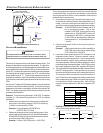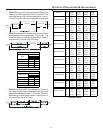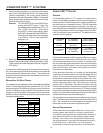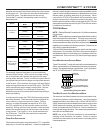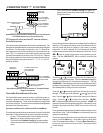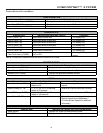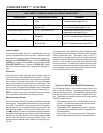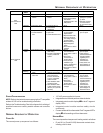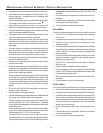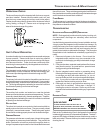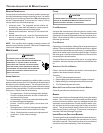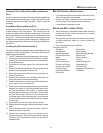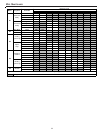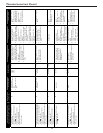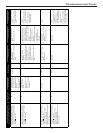
48
O
PERATIONAL
C
HECKS
& S
AFETY
C
IRCUIT
D
ESCRIPTION
• Integrated control module performs safety circuit checks.
• Induced draft blower is energized on high speed for a 15-
second prepurge. Humidifier terminal is energized with
induced draft blower.
• Induced draft blower steps to low speed following prepurge.
Low stage pressure switch contacts are closed.
• Igniter warm up begins upon step to low speed and
presence of closed low stage pressure switch contacts.
• Gas valve opens at end of igniter warm up period, delivering
gas to burners and establishing flame.
• Integrated control module monitors flame presence. Gas
valve will remain open only if flame is detected.
• If the thermostat call is for low heat, gas valve and induced
draft blower will continue on low stage. If the call is for high
heat, the gas valve and induced draft blower will change to
high stage.
• Circulator blower is energized on heat speed following a
thirty (30) second blower on delay. The circulator blower
requires thirty seconds to ramp up to full speed. Electronic
air cleaner terminal is energized with circulator blower.
• Furnace is now operating on the specified stage called for
by the two-stage thermostat.
• Furnace runs, integrated control module monitors safety
circuits continuously.
• If the two-stage thermostat changes the call from low heat
to high heat, the integrated control module will immediately
switch the induced draft blower, gas valve, and circulator
blower to their high stage settings.
• If the two-stage thermostat changes the call from high heat
to low heat, the control will immediately switch the induced
draft blower and gas valve to their low stage settings. The
circulator blower will remain on high heating speed for thirty
(30) seconds before switching to the low heat circulating
speed.
• R and W1 (or R and W1/W2) thermostat contacts open,
completing the call for heat.
• Gas valve closes, extinguishing flame.
• Induced draft blower is de-energized following a fifteen second
post purge. Humidifier terminals are de-energized.
• Circulator blower continues running for the selected heat
off delay period (90, 120, 150 or 180 seconds). The speed
run during this period depends on the last heat call provided
by the thermostat.
If the last call for heat was a call for low heat, the air circulator
motor will run on low heat speed for the duration of the heat
off delay period (90, 120, 150 or 180 seconds).
If the last call for heat was a call for high heat, the air
circulating motor will run on the high heating speed for thirty
(30) seconds and then switch to the low heating speed for
the balance of the heat off delay period (60, 90, 120 or 150
seconds).
• Circulator blower and electronic air cleaner terminal is de-
energized.
• Circulator blower ramps down to OFF during the 30 seconds
following the heat off delay period.
• Furnace awaits next call from thermostat.
COOLING M ODE
The normal operational sequence in cooling mode is as follows:
• R and Y1/G or Y2/G thermostat contacts close, initiating a
call for cool.
• Integrated control module performs safety circuit checks.
• Outdoor fan and compressor are energized to their
appropriate speed.
• Circulator blower is energized on the appropriate cool speed
at the level and time determined by the selected ramping
profile. Electronic air cleaner terminal is energized with
circulator blower.
• Furnace circulator blower and outdoor cooling unit run their
appropriate speeds, integrated control module monitors
safety circuits continuously.
• R and Y1/G or Y2/G thermostat contacts open, completing
the call for cool.
• Outdoor fan and compressor are de-energized.
• Circulator blower continues running during a cool off delay
period. The OFF delay time and airflow level are determined
by the selected ramping profile.
• Electronic air cleaner terminal and circulator blower are de-
energized.
• Furnace awaits next call from thermostat.
FAN O NLY M ODE
The normal operational sequence in fan only mode is as follows:
• R and G thermostat contacts close, initiating a call for fan.
• Integrated control module performs safety circuit checks.
• Circulator blower is energized on continuous fan speed (30%
of the furnace’s maximum airflow capability) following a five
(5) second delay. Electronic air cleaner terminal is energized.
• Circulator blower runs, integrated control module monitors
safety circuits continuously.
• R and G thermostat contacts open, completing the call for
fan.
• Circulator blower is de-energized. Electronic air cleaner
terminal is de-energized.
• Furnace awaits next call from thermostat.



